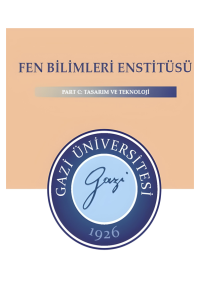ÖN KARIŞIMLI BİR YANMA ODASINDA METANIN YANMA KARAKTERİSTİKLERİNİN RENKSİZ DAĞITILMIŞ YANMA ŞARTLARINDA SAYISAL OLARAK İNCELENMESİ
Abstract
Dünya genelinde enerji ihtiyacındaki artış ve fosil enerji kaynaklarının tükeniyor olması sebebiyle kaynakların daha verimli kullanılması gerekmektedir. Kullanılan kaynakların çevreye olan zararları ise enerji ihtiyacındaki artış ile paralel olarak artmakta ve geri dönülemez zararlara sebep olmaktadır. Renksiz dağıtılmış yanma yaklaşımı ile yakıtların çevreye olan zararlarını minimuma indirmek amaçlanmış ve bu çalışmada da renksiz dağıtılmış yanma metodu uygulanmıştır. Yanma koşulları için hazırlanmış olan bir yakıcı içerisine ön karışımlı olarak hava-yakıt karışımı gönderilmiş ve farklı koşullar altında hava fazlalık katsayısı (λ) değiştirilerek sonuçlar incelenmiştir. Hava-yakıt oranı değiştirilerek (λ=1.2 ve λ=1.7) yanma sonucu ortaya çıkan CO, CO2, NOx emisyonlarını düşürmek amaçlanmıştır. Modellemeler Ansys Fluent Student Edition yazılımı kullanılarak gerçekleştirilmiştir. Ansys Fluent yazılımında üç boyutlu sayısal modelleme için Species Transport yanma modeli ve P-1 radyasyon modeli seçilmiştir. Yanma modeli GRI-MECH kullanılmış, 64 basamaklı bir kimyasal reaksiyon oluşturulmuş ve Eddy Dissipation Concept modeli ile entegrasyonu yapılarak gerçekleştirilmiştir. Model ve reaksiyon sonucu doğrulaması için elde edilen deney sonuçlarıyla sabit yanma koşullarının karşılaştırılması yapılmıştır. Oksitleyici olarak hava kullanılmış ancak yakıt ile oksitleyici yanma odasına girmeden önce karıştırılarak kullanılmıştır. İlk koşul için hava fazlalık katsayısı λ= 1.2 karşılaştırılacak ikinci koşul için ise hava fazlalık katsayısı λ= 1.7 seçilmiş ve 10kW güç altında çalışılmıştır. Renksiz dağıtılmış yanma şartları ise yakıt hava karışımı içerisindeki oksijen oranları sırasıyla %21 O2 (renksiz dağıtılmış yanma şartlarının uygulanmadığı oran) %19 O2, %17 O2 ve %15 O2 olacak şekilde uygulanmıştır. Uygulama sonucunda ortaya çıkan yakıt hava oranları tablolarda gösterilmiş ve sonuçları karşılaştırılmıştır. Renksiz dağıtılmış yanma koşulları uygulanırken yanma odasına giren O2 konsantrasyonu oransal olarak azaltılması için seyreltici olarak N2 beslenmiş ve yanma koşuları buna göre incelenmiştir. Sonuçlar irdelendiğinde, renksiz dağıtılmış yanma ile daha homojen bir sıcaklık dağılımı elde edilirken CO2, NOX ve CO emisyonlarında önemli derecede azalmalar gözlenmiştir.
References
- Karyeyen, S., Feser, J.S. and Gupta, A.K. (2019). Khalil, A.E.E. and Gupta, A.K. (2013). Hydrogen addition effects on high intensity distributed combustion. Applied Energy, 104 (1), 71-79. Yu, Y., Gaofeng, W., Qizhao, L., Chengbiao, M. and Xianjun, X. (2010). Flameless combustion for hydrogen containing fuels. International Journal of Hydrogen Energy, 35(1), 2694-2697 [Derudi, M., Villani, A. and Rota, R. (2007). Khalil, A.E.E. and Gupta, A.K. (2016). Fuel property effects on distributed combustion. Fuel, 171(1), 116-124.
NUMERICAL INVESTIGATION OF THE COMBUSTION CHARACTERISTICS OF METHANE IN A PRE-MIXED COMBUSTION ROOM UNDER COLORLESS DISTRIBUTED COMBUSTION CONDITIONS
Abstract
Due to the increase in energy demand and the depletion of fossil energy resources worldwide, resources should be used more efficiently. The damage to the environment of the resources used increases in parallel with the increase in energy demand and causes irreversible damages. With the colorless distributed combustion approach, it was aimed to minimize the environmental damage of the fuels and in this study, the colorless distributed combustion method was applied. Premixed air-fuel mixture was sent into a combustor prepared for combustion conditions and the results were examined by changing the excess air coefficient (λ) under different conditions. By changing the air-fuel ratio (λ=1.2 and λ=1.7), it is aimed to reduce CO, CO2, NOx emissions resulting from combustion. Modeling was performed using Ansys Fluent Student Edition software. Species Transport combustion model and P-1 radiation model were selected for three-dimensional numerical modeling in Ansys Fluent software. Combustion model GRI-MECH was used, a 64-step chemical reaction was created and integrated with the Eddy Dissipation Concept model. For the validation of the model and reaction results, the experimental results obtained were compared with the constant combustion conditions. Air was used as the oxidizer, but mixed with the fuel before the oxidant entered the combustion chamber. For the first condition, the excess air coefficient λ= 1.2 will be compared, and for the second condition, the excess air coefficient λ= 1.7 was chosen and it was operated under 10kW power. Colorless dispersed combustion conditions were applied such that the oxygen ratios in the fuel-air mixture were 21% O2 (the rate where colorless dispersed combustion conditions were not applied), 19% O2, 17% O2 and 15% O2. The fuel-air ratios resulting from the application are shown in the tables and the results are compared. While applying colorless dispersed combustion conditions, N2 was fed as a diluent in order to proportionally decrease the O2 concentration entering the combustion chamber and the combustion conditions were examined accordingly. When the results were examined, a more homogeneous temperature distribution was obtained with colorless dispersed combustion, while significant reductions in CO2, NOX and CO emissions were observed.
References
- Karyeyen, S., Feser, J.S. and Gupta, A.K. (2019). Khalil, A.E.E. and Gupta, A.K. (2013). Hydrogen addition effects on high intensity distributed combustion. Applied Energy, 104 (1), 71-79. Yu, Y., Gaofeng, W., Qizhao, L., Chengbiao, M. and Xianjun, X. (2010). Flameless combustion for hydrogen containing fuels. International Journal of Hydrogen Energy, 35(1), 2694-2697 [Derudi, M., Villani, A. and Rota, R. (2007). Khalil, A.E.E. and Gupta, A.K. (2016). Fuel property effects on distributed combustion. Fuel, 171(1), 116-124.
Details
| Primary Language | Turkish |
|---|---|
| Subjects | Engineering |
| Journal Section | Research Article |
| Authors | |
| Publication Date | December 30, 2022 |
| Submission Date | July 31, 2022 |
| Published in Issue | Year 2022 Volume: 10 Issue: 4 |


